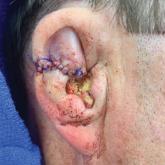Article

Chondrodermatitis Nodularis Helicis After Mohs Micrographic Surgery and Radiation Therapy
- Author:
- Andrew M. Armenta, MD
- Vlad A. Codrea, MD, PhD
- Emily L. Sou, MD
- Richard F. Wagner Jr, MD
Although chondrodermatitis nodularis helicis is benign by nature, it can mimic tumor recurrence when it presents close to the site of prior Mohs...
